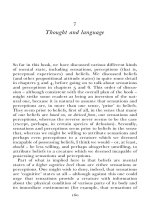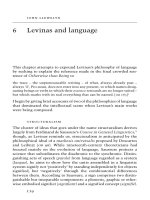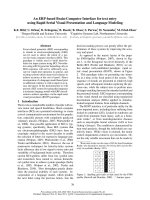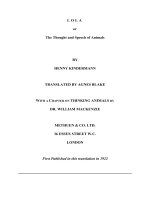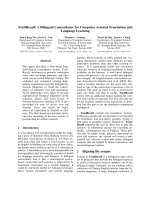Thought and language
Bạn đang xem bản rút gọn của tài liệu. Xem và tải ngay bản đầy đủ của tài liệu tại đây (218.15 KB, 33 trang )
7
Thought and language
So far in this book, we have discussed various different kinds
of mental state, including sensations, perceptions (that is,
perceptual experiences) and beliefs. We discussed beliefs
(and other propositional attitude states) in quite some detail
in chapters 3 and 4, before going on to talk about sensations
and perceptions in chapters 5 and 6. This order of discus-
sion – although consistent with the overall plan of the book –
might strike some readers as being an inversion of the nat-
ural one, because it is natural to assume that sensations and
perceptions are, in more than one sense, ‘prior’ to beliefs.
They seem prior to beliefs, first of all, in the sense that many
of our beliefs are based on,orderived from, our sensations and
perceptions, whereas the reverse never seems to be the case
(except, perhaps, in certain species of delusion). Secondly,
sensations and perceptions seem prior to beliefs in the sense
that, whereas we might be willing to attribute sensations and
perhaps even perceptions to a creature which we deemed
incapable of possessing beliefs, I think we would – or, at least,
should – be less willing, and perhaps altogether unwilling, to
attribute beliefs to a creature which we deemed incapable of
possessing sensations and perceptions.
Part of what is implied here is that beliefs are mental
states of a higher cognitive level than are either sensations or
perceptions. One might wish to deny, indeed, that sensations
are ‘cognitive’ states at all – although against this one could
urge that sensations provide a creature with information
about the physical condition of various parts of its body and
its immediate environment (for example, that sensations of
160
Thought and language 161
pain inform it about damage to certain of its body-parts and
that sensations of smell inform it about the presence of food
or other animals). Perceptions, on the other hand, clearly qual-
ify as ‘cognitive’ states, if – as was urged in chapter 6 –we
should think of them as necessarily possessing conceptual
content: for an ability to exercise concepts is undoubtedly a
cognitive ability. The adjective ‘cognitive’ derives from the
Latin verb cognoscere, meaning ‘to know’, and knowledge
properly so-called is inextricably bound up with an ability
to exercise concepts. However, this very connection between
cognition and concept-possession should make us reconsider
whether the kind of information made available to a creature
by its sensations suffices to justify our describing sensations
as ‘cognitive’ states. Arguably, it does not suffice, since no
exercise of concepts on the part of the creature need be
involved. A dog which licks its wounded leg, upon feeling a
sensation of pain there, is clearly in some sense responding
to information made available to it about the physical condi-
tion of its leg. But in order to respond appropriately in this
way, the dog does not apparently need to exercise concepts of
any sort. It need, in particular, possess no concept of a leg,
nor of damage, nor of itself, nor indeed of pain.
Having made this connection between cognition and con-
cept-possession, however, we may begin to feel dissatisfied
with some aspects of the discussion about beliefs and their
‘propositional content’ in chapter 4. In particular, we may
feel that beliefs were there treated merely as ‘representa-
tional’ or ‘informational’ states, in a way which was quite
insensitive to the distinction between those mental states
which do, and those which do not, presuppose an ability to
exercise concepts on the part of creatures possessing the
states in question. That is one very important reason why we
must now return to the topic of belief and, more broadly, to
the topic of thought. Our preliminary investigations into this
area in chapters 3 and 4 were not in vain, inconclusive
though they were. Now we are in a position to carry them
further forward in the light of what we have learnt about
sensation and perception. For one thing which we must try
An introduction to the philosophy of mind162
to understand is how sensation and perception are related to
thought and belief. Another is how thought and belief are
related to their expression in language.
Some of the questions that we shall address in this chapter
are the following. Is all thought symbolic and quasi-linguistic
in character? Is there a ‘brain code’ or ‘language of thought’?
What is the role of mental imagery in our thinking processes?
How far is a capacity for thought dependent upon an ability
to communicate in a public language? Does the language
which we speak shape or constrain the thoughts that we are
capable of entertaining? And to what extent are our capacit-
ies for language innate?
MODES OF MENTAL REPRESENTATION
Let us begin with the seemingly innocuous proposition that
cognitive states, including thoughts and beliefs, are at once
mental states and representational states. Now, I have already
suggested that talk of ‘representation’ in this context is
somewhat indiscriminate, in that it is insensitive to the dis-
tinction between conceptual and non-conceptual content
(recall our discussion of this point in the previous chapter).
However, precisely for this reason, such talk carries with it a
smaller burden of assumptions than would more specific ways
of talking, which gives it certain advantages. The questions
we need to think about now are (1) how mental states could
be representational states and (2) what modes of representa-
tion they must involve in order to qualify as cognitive states.
It is in addressing the latter question that we can impose the
constraint that cognitive states must be seen as possessing
some kind of conceptual content.
We have already given the first question a good deal of
consideration in chapter 4, where we explored various natur-
alistic accounts of mental representation (although, to be
sure, we found reason to be less than fully satisfied with
these). So let us now concentrate on the second question.
Here we may be helped by reflecting on the many different
modes of non-mental representation with which we are all
Thought and language 163
familiar. The wide variety of these modes is illustrated by the
very different ways in which items of the following kinds
serve to represent things or states of affairs: pictures, photo-
graphs, diagrams, maps, symbols, and sentences. All of these
familiar items are, of course, human artefacts, which people
have designed quite specifically in order to represent some-
thing or other. Indeed, it is arguable that every such artefact
succeeds in representing something only insofar as some-
one – either its creator or its user – interprets it as repres-
enting something. If that is so, we might seem to be faced
with a difficulty if we tried to use such items as models for
understanding modes of mental representation. For – quite
apart from its inherent implausibility – it would surely
involve either a vicious circle or a vicious infinite regress to
say that mental representations succeed in representing some-
thing only insofar as someone interprets them as repres-
enting something. For interpreting is itself a representational
mental state (in fact, a kind of cognitive state). One way of
putting this point is to say that human artefactual repres-
entations, such as pictures and maps, have only ‘derived’, not
‘original’, intentionality – intentionality being that property
which a thing has if it represents, and thus is ‘about’, some-
thing else (in the way in which a map can be ‘about’ a piece
of terrain or a diagram can be ‘about’ the structure of a
machine).
1
We may respond to the foregoing difficulty in the following
way. First of all, the fact (if it is a fact) that artefactual rep-
resentations have only derived intentionality, while it might
prevent us from appealing to them in order to explain how
mental representations can be representational states –
which was question (1) above – would not prevent us from
appealing to them for the purposes of answering question
(2), that is, as providing models of various different possible
1
For discussion of the distinction between ‘original’ (or ‘intrinsic’) intentionality
and ‘derived’ intentionality, see John R. Searle, The Rediscovery of the Mind
(Cambridge, MA: MIT Press, 1992), pp. 78–82. For more about the notion of
intentionality quite generally, see his Intentionality: An Essay in the Philosophy of
Mind (Cambridge: Cambridge University Press, 1983).
An introduction to the philosophy of mind164
modes of mental representation. It could be, for example, that
certain modes of mental representation are profitably
thought of as being analogous to sentences, as far as their form
or structure is concerned. Certainly, it would be unpromising
to maintain that such a mental ‘sentence’ serves to represent
something – some state of affairs – for the same sort of
reason that a written sentence of English does, since it seems
clear that sentences of English only manage to represent any-
thing in virtue of the fact that English speakers interpret them
as doing so. Hence, we must look elsewhere for an account of
how a mental ‘sentence’ could manage to represent anything
(appealing, perhaps, to one of the naturalistic accounts
sketched in chapter 4). However, it might still be the case
that there is something about the structure of natural lan-
guage sentences which makes them a promising model for
certain modes of mental representation. This is the issue that
we shall look into next.
THE ‘LANGUAGE OF THOUGHT’ HYPOTHESIS
The following line of argument provides one reason for sup-
posing that cognitive states, including thoughts and beliefs,
must be conceived of as involving some sort of quasi-linguistic
mode of representation. We have already made the point that
cognitive states have conceptual content. But, more than that,
they have conceptual structure. Compare the following beliefs:
the belief that horses like apples, the belief that horses like
carrots, the belief that squirrels like carrots and the belief
that squirrels like nuts. Each of these beliefs shares one or
more conceptual components with the others, but they all
have the same overall conceptual structure – they are all
beliefs of the form: Fs like Gs. Now, sentences of a language
are admirably suited to capturing such structure, because
they are formed from words which can be recombined in vari-
ous ways to generate new sentences with the same or differ-
ent structure. The grammatical or syntactical rules of a lan-
guage determine what forms of combination are admissible.
A competent speaker, who has an implicit knowledge of those
Thought and language 165
rules together with a large enough vocabulary – which may,
however, comprise only a few thousand words – can construct
a vast number of different sentences, many of which he may
never have encountered before, in order to express any of a
vast range of thoughts that may come into his head. The
productivity of language, then – its capacity to generate an
indefinitely large number of sentences from a limited vocabu-
lary – seems to match the productivity of thought, which sug-
gests a close connection between the two. A plausible hypo-
thesis is that the productivity of thought is explicable in the
same way as that of language, namely, that it arises from the
fact that thought involves a structural or compositional mode
of representation analogous to that of language. Unsurpris-
ingly, the existence of just such a mode of mental repres-
ention has indeed been postulated, going under the title of
‘the language of thought’ or ‘Mentalese’.
2
In describing the putative language of thought as being a
language, we must be wary not to assimilate it too closely to
familiar natural languages, such as English or Swahili. The
only relevant similarity is structural – the possession of ‘syn-
tactical’ organisation. Mentalese, if it exists, is a language in
which we think, but not one in which we speak or communicate
publicly. Moreover, if we do think in Mentalese, we are
clearly not consciously aware of doing so: sentences of Menta-
lese are not disclosed to us when we reflect, or ‘introspect’,
upon our own thought processes. Thus, sentences of Menta-
lese are not to be confused with ‘inner speech’ or ‘silent soli-
loquy’ – the kind of imaginary dialogue that we often hold
with ourselves as we work out the solution to some problem
or ponder over a decision we have to make. For we conduct
this kind of imaginary dialogue in our native tongue or, at
2
The most fully developed defence of the language of thought hypothesis, drawing
on arguments of the kind sketched in this section, is to be found in Jerry A. Fodor,
The Language of Thought (Hassocks: Harvester Press, 1976). ‘Mentalese’ is Wilfrid
Sellars’ name for the language of thought: see his ‘The Structure of Knowledge
II’, in H. N. Castan
˜
eda (ed.), Action, Knowledge, and Reality: Critical Studies in Honor
of Wilfrid Sellars (Indianapolis: Bobbs-Merrill, 1975). See also Hartry Field,
‘Mental Representation’, Erkenntnis 13 (1978), pp. 9–61, reprinted in Ned Block
(ed.), Readings in Philosophy of Psychology, Volume 2 (London: Methuen, 1981).
An introduction to the philosophy of mind166
least, in some natural language known to us, be it English or
German or some other human tongue.
But why, apart from the foregoing considerations about
the productivity of thought, should we suppose that Menta-
lese exists? Various additional reasons have been offered.
One is this. It may be urged that the only way in which one
can learn a language is by learning to translate it into a lan-
guage which one already knows. This, after all, is how a
native English speaker learns a foreign language, such as
French, namely, by learning to translate it into English
(unless, of course, he picks it up ‘directly’, in which case he
presumably learns it in much the same way as he learnt
English). But if that is so, then we can only have learnt our
mother tongue (our first natural language) by learning to
translate it into a language our knowledge of which is innate
(and thus unlearned) – in short, by learning to translate it
into Mentalese, or the ‘language of thought’. However,
although learning a language by learning to translate it cer-
tainly is one way of learning a language, it may be questioned
whether it is the only way. Someone hostile to Mentalese
could easily turn the foregoing argument around and main-
tain that, since (in his view) there is no such thing as Menta-
lese, it follows that there must be a way to learn a language
which does not involve translating it into a language which
one already knows. But then, of course, it would be incum-
bent upon such a person to explain what this other way could
be, which might not be at all easy. We shall return to this
issue later, when we come to consider to what extent our
knowledge of language is innate.
Another consideration ostensibly favouring the language of
thought hypothesis is that postulating the existence of such
a language would enable us to model human thought-
processes on the way in which a digital electronic computer
operates. Such a device provides, it may be said, our best
hope of understanding how a wholly physical system can pro-
cess information. In the case of the computer, this is achieved by
representing information in a quasi-linguistic way, utilising a
binary ‘machine code’. Strings of this code consist of
Thought and language 167
sequences of the symbols ‘0’ and ‘1’, which can be realised
physically by, say, the ‘off ’ and ‘on’ states of electronic
switches in the machine. If the human brain is an informa-
tion-processing device, albeit a naturally evolved one rather
than the product of intelligent design, then it may be reason-
able to hypothesise that it operates in much the same way as
an electronic computer does, at least to the extent of utilising
some sort of quasi-linguistic method of encoding information.
Mentalese might be seen, then, as a naturally evolved ‘brain
code’, analogous to the machine code of a computer. On the
other hand, doubts have been raised by many philosophers
and psychologists about the computational approach to the
mind, some of which we aired in the previous chapter. We
shall look into this question more fully in the next chapter,
when we discuss the prospects for the development of artifi-
cial intelligence. In the meantime, we would do well not to
put too much weight on purported analogies between brains
and computers. Moreover, as we shall see in the next chapter,
there are styles of computer architecture – notably, so-called
‘connectionist’ ones – which do not sustain the kind of ana-
logy which has just been advanced on behalf of the language
of thought hypothesis.
3
ANALOGUE VERSUS DIGITAL REPRESENTATION
Sentences of a language, as we have just seen, provide one
possible model for the mode of mental representation
involved in human thought processes. But earlier on we listed
many other kinds of artificial representation besides sen-
tences – items such as pictures, photographs, diagrams and
3
For evaluation of Fodor’s arguments in The Language of Thought, see Daniel C.
Dennett’s critical notice of the book in Mind 86 (1977), pp. 265–80, reprinted as
‘A Cure for the Common Code?’, in Dennett’s Brainstorms: Philosophical Essays on
Mind and Psychology (Hassocks: Harvester Press, 1979) and also in Block (ed.),
Readings in Philosophy of Psychology, Volume 2. For other criticisms of the language
of thought hypothesis and an alternative perspective, see Robert C. Stalnaker,
Inquiry (Cambridge, MA: MIT Press, 1984), ch. 1 and ch. 2. Fodor further defends
the hypothesis in the Appendix to his Psychosemantics: The Problem of Meaning in the
Philosophy of Mind (Cambridge, MA: MIT Press, 1987).
An introduction to the philosophy of mind168
maps. All of these items involve some element of analogue –
as opposed to digital – representation. The analogue/digital
distinction can be illustrated by comparing an analogue
clock-face with a digital clock-face. Both types of clock-face
represent times, but do so in quite different ways. A digital
clock-face represents time by means of a sequence of
numerals, such as ‘10.59’. An analogue clock-face represents
that same time by the positions of the hour hand and the
minute hand of the clock. More particularly, an analogue
clock-face represents differences between hours by means of
differences between positions of the hour hand, in such a way
that the smaller the difference is between two hours, the
smaller is the difference between the positions representing
those hours (and the same applies to the minute hand). Thus
the analogue clock-face represents by drawing upon an ana-
logy, or formal resemblance, between the passage of time and
the distances traversed by the clock’s hands.
4
The analogue representation involved in an analogue
clock-face is highly abstract or formal. Maps and diagrams
are less formal than this, since they bear some genuine
resemblance, however slight or stylised, to the things which they
represent. Thus a map representing some piece of terrain is
spatially extended, just as the terrain is, and represents
nearby parts of the terrain by nearby parts of the map. Other
aspects of map-representation may be more formal, however.
For example, if the map is a contour map, it represents the
steepness of part of the terrain by the closeness of the contour
lines in the part of the map representing that part of the
terrain. A map may also include elements of purely symbolic
representation, which qualify as ‘digital’ rather than ‘ana-
logue’ – such as a cross to represent the presence of a church
(though, even here, the location of the cross represents the
location of the church in an analogue fashion). Pictures and
photographs represent by way of even more substantial
4
For further discussion of the analogue/digital distinction, see Zenon W. Pylyshyn,
Computation and Cognition: Toward a Foundation for Cognitive Science (Cambridge, MA:
MIT Press, 1984), ch. 7.
Thought and language 169
degrees of resemblance between them and the things which
they represent: thus, in a colour photograph which is, as we
say, a ‘good likeness’ of a certain person, the colour of that
person’s hair resembles the colour of the region of the photo-
graph which represents that person’s hair. In this case, the
resemblance needs to be of such an order that the experience
of looking at the photograph is (somewhat) similar to the
experience of looking at the person. But, of course, looking
at a photograph of a person isn’t exactly like looking at a
person – and seeing a photograph as representing a person
requires interpretation quite as much as does seeing a map as
representing a piece of terrain.
IMAGINATION AND MENTAL IMAGERY
An obvious question to ask at this point is this. Do any of
our cognitive states involve analogue modes of representation?
How, though, should we attempt to find the answer to this
question? Perhaps we could just ask people for their opinion
about this, relying on their powers of introspection. But if we
ask people whether, for instance, they think ‘in words’ or ‘in
images’, we find that we get a surprisingly varied range of
answers. Some people assert that their thinking is frequently
accompanied by vivid mental imagery, while others emphat-
ically deny that they ever experience such imagery and even
profess not to understand what is meant by talk of it. Some
of the latter people, however, happily assert that they think
‘in words’ – by which they mean words of some natural lan-
guage, such as English. But then it appears that their think-
ing is accompanied by mental imagery after all, but just by
auditory imagery rather than by visual imagery.
What, though, is the connection between mental imagery
and modes of mental representation? It is dangerously easy
to slip into arguing in the following fashion. Mental imagery,
whether visual or auditory, manifestly accompanies much or
all of our conscious thinking. But mental images are images
and thus involve analogue representation. Hence, much of
our thinking involves analogue modes of representation. One
An introduction to the philosophy of mind170
questionable assumption in this line of reasoning is the
assumption that mental imagery literally involves images of
some sort, where by an ‘image’ is meant something akin to a
picture or a photograph. It is difficult to dispute that we all
engage, at times, in processes of imagination. Thus, if someone
instructs me, say, to imagine a white horse galloping across
a green field, I know how to carry out that instruction – I
‘visualise’ a scene corresponding to the given description. But
we shouldn’t assume, just because the term ‘imagination’ is
derived from the same root as the term ‘image’, that ima-
gination must therefore involve the production or inspection
of images of any kind. It may be that imagination has acquired
this name because people in the past believed that it involved
images of some kind. However, we shouldn’t assume that that
belief is correct. But – it may be asked – isn’t it just obvious
that when you visualise something you see something ‘in your
mind’s eye’ – a ‘mental picture’? No, it isn’t at all obvious
that this is so. The most that can safely be said is that the
experience of visually imagining something is somewhat like
the experience of seeing something. But since it is far from
obvious that the experience of seeing something involves any
kind of ‘mental picture’, why should it be supposed that the
experience of visually imagining something does? It won’t do
to answer here that because, when you visually imagine
something, the thing you imagine needn’t exist, there must
therefore be something else that really does exist and which you
‘see in your mind’s eye’ – a ‘mental picture’ of the thing
which you are imagining. For why should you have to see
something else in order to visualise something which doesn’t
exist?
The question that we need to address at this point is the
following. Granted that much of our conscious thinking
involves the exercise of our powers of imagination, what
reason is there to suppose that processes of imagination
involve analogue modes of representation? One way of trying
to approach this question is to ask whether imagining a situ-
ation is more akin to depicting it or to describing it. Thus, con-
sider again what you do when you are instructed to imagine
Thought and language 171
a white horse galloping across a green field – and compare
this with what you do when you are instructed to paint a pic-
ture of a white horse galloping across a green field. Suppose I
ask you, concerning your imagined scene, whether the sky
was blue or whether there were any trees nearby. In all prob-
ability, you will say that you just didn’t think about those
matters one way or the other. But your painting could not
easily be so non-committal. You may have decided not to
include the sky in your picture, but if you did include it, you
will have to have given it some colour. Likewise, you will have
to have made a decision about whether or not to include any
other objects in the picture besides the horse, such as some
trees. In this respect, imagining seems to be rather more like
describing than depicting, because a description is similarly
non-committal about items not explicitly included in the
description. Two famous examples often cited in illustration
of this point are those of the speckled hen and the striped
tiger.
5
When a person depicts such a creature, he or she must
(it is said) depict it as having a determinate number of
(visible) speckles or stripes. But when a person imagines such
a creature, it may be futile to inquire how many speckles or
stripes the imagined creature possessed, because the person
imagining it may simply have failed to think about the
matter one way or another. On the other hand, it seems that
imagining is not as completely non-committal about such
things as describing is. If I ask you to imagine a striped tiger,
I would expect you to be able to say whether you imagined
it as lying down or as moving and as facing you or as seen
from one side. The bare description of a situation as being
one which includes a striped tiger is, by contrast, com-
pletely silent about such matters. So perhaps imagining does
involve some degree of analogue representation. But maybe
5
For discussion of the example of the tiger and its stripes and a defence of a
descriptional view of imagination, see Daniel C. Dennett, Content and Consciousness
(London: Routledge and Kegan Paul, 1969), pp. 132–41, reprinted in Block (ed.),
Readings in Philosophy of Psychology, Volume 2 and in Ned Block (ed.), Imagery
(Cambridge, MA: MIT Press, 1981). Somewhat confusingly, Dennett uses ‘depic-
tional’ as synonymous with ‘descriptional’ and contrasts both with ‘pictorial’.
An introduction to the philosophy of mind172
it is more like drawing a map or a diagram than painting a
picture.
However, the trouble with the foregoing approach to the
question just raised is that it still relies on dubious appeal to
our powers of introspection. Isn’t there a more objective way
to settle the matter? Some empirical psychologists certainly
think so. They believe that experimental evidence supports
the contention that analogue modes of representation are
involved in some of our thinking processes. One well-known
experimental technique involves showing subjects pictures,
projected on to a screen, of pairs of asymmetrically shaped
objects, constructed out of uniformly sized cubic blocks. In
some cases, both objects in a pair are exactly the same in
shape, but one is depicted as having been rotated through a
certain angle with respect to the other. In other cases, the
two objects in a pair are subtly different in shape as well as
in orientation. In each case, after the picture has been
removed from the screen, subjects are asked to say whether
or not the depicted pair of objects had the same shape. One
of the findings is that, when the two objects in a pair have
the same shape, the length of time it takes subjects to deter-
mine that this is so is roughly proportional to the size of the
angle through which one of the objects is depicted as having
been rotated with respect to the other. The proffered
explanation of this finding – and one which seems to be cor-
roborated by the introspective reports of the subjects con-
cerned – is that subjects solve this problem by ‘mentally
rotating’ a remembered ‘image’ of one of the objects to deter-
mine whether or not it can be made to coincide with their
remembered ‘image’ of the other object. The length of time
which it takes them to do this depends, it is suggested, on
the size of the angle through which they have to ‘rotate’ one
of the ‘images’ – on the seemingly reasonable assumption
that their ‘speed of mental rotation’ is fairly constant – thus
explaining the experimentally established correlation
between the length of time which subjects take to reach their
verdict and the size of the angle through which one of the
objects was depicted as having been rotated with respect to


